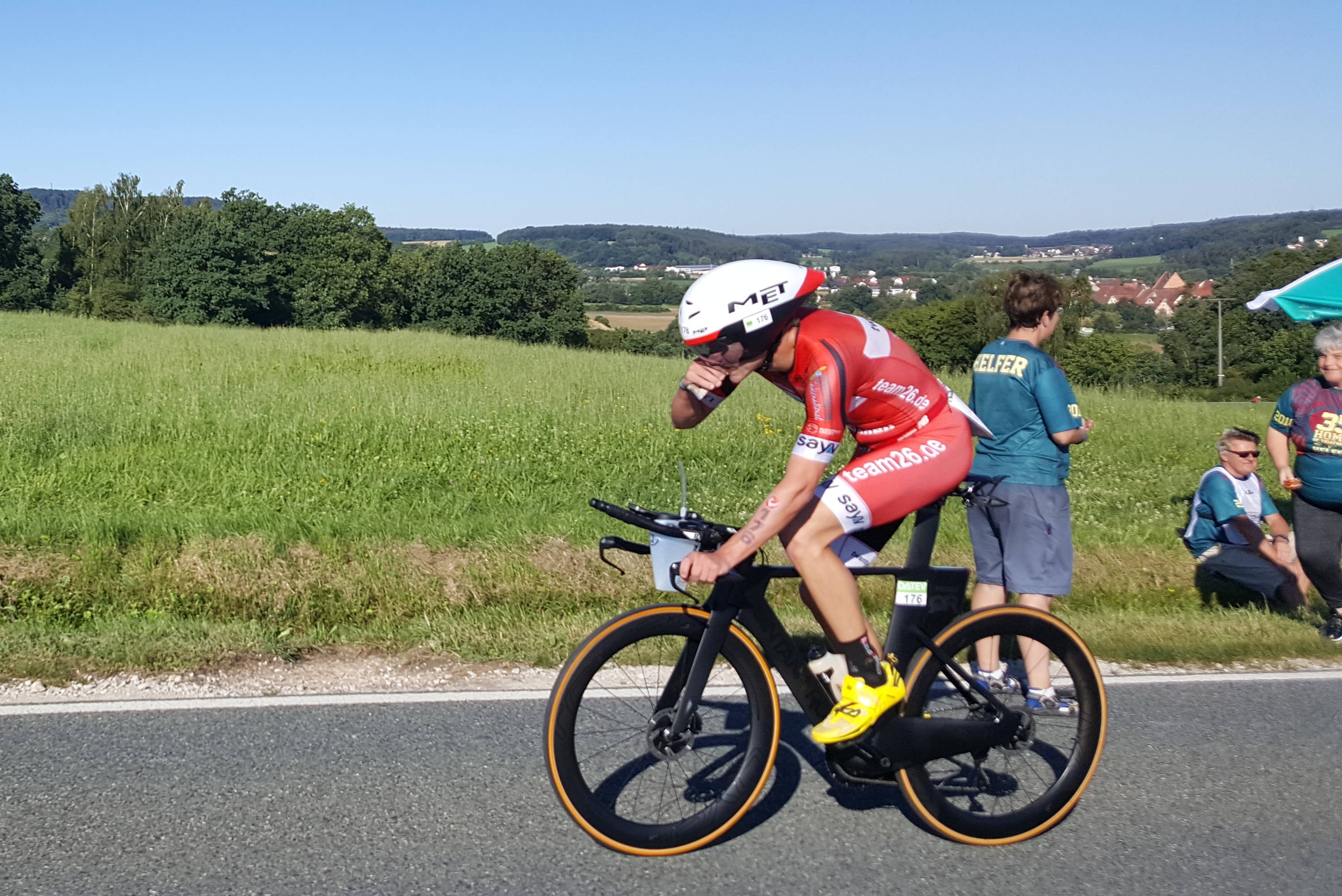Gerade bei Mittel- und Langdistanzen ist vor allem die Fähigkeit zur kontinuierlichen Energiebereitstellung ein leistungsbegrenzender Faktor. Gleichzeitig aber auch DER Schlüssel zum Erfolg!
Mittel- und Langdistanztriathlons sind im Unterschied zu den kurzen Wettkampfformaten von einer Belastungsstruktur im subschwelligen Intensitätsbereich geprägt. Dieser soll ohne Leistungsabfall über einen langen Zeitraum möglichst gleichmäßig aufrechterhalten werden. Die langandauernde aerobe Versorgung der Arbeitsmuskulatur ist hier von entscheidender Bedeutung für die erfolgreiche Wettkampfleistung.
Ein Rechenbeispiel:
Ein Athlet verbrennt bei hoher Intensität ca. 1.000 kcal/h. Aufgrund des hohen Wettkampftempos wird der gesamte Energiebedarf aus KH generiert. Gut gefüllte Glykogenspeicher liefern eine Gesamtenergiemenge von ca. 2.000 kcal/h, also ausreichend für ca. 2 Stunden Wettkampfdauer. Zusätzlich nimmt der Sportler Riegel und Gels zu sich. Jedoch ist die Magenaufnahmekapazität unter sportlicher Belastung begrenzt und liegt bei ca. 60-100g KH/Stunde. Dies entspricht einer Energiemenge von ca. 300-400 kcal/h. Maximal! In Summe sind die zugeführten und körpereigen Reserven daher nach 3 Stunden aufgebraucht, der „Mann mit dem Hammer“ kommt. Energieloch, Kraftlosigkeit, Leistungsabfall. Ein Killer auf der Langdistanz!
Was passiert im Körper?
Kohlenhydrate (KH) und Fette (F) sind die Hauptenergieträger des Körpers und werden in den Muskelzellen verbrannt. Die freigesetzte Energie ermöglicht die muskuläre Arbeit. Für die lang andauernde
Ausdauerleistung ist jedoch entscheidend, in welchem Verhältnis die Energieträger zum Einsatz kommen, denn KH und F unterscheiden sich grundlegend in der Art der Energieumsetzung. Dabei hat die Intensität der Belastung entscheidenden Einfluss darauf, aus welchem Speicher sich der Körper bedient:
Fette sind im Körper als komplexe Molekülketten gespeichert und stehen fast unbegrenzt zur Verfügung. Die Energiegewinnung erfolgt verhältnismäßig langsam und ausschließlich aerob (mit Sauerstoff). Daher werden Fettsäuren vorwiegend bei einem niedrigen bis mittleren Belastungsniveau umgesetzt. Die verfügbare Energiemenge reicht dafür theoretisch für mehrere Ironman-Distanzen hintereinander.
Je schneller und intensiver die Belastungsintensität ist, desto weniger können Fette verstoffwechselt werden. Stattdessen steigt der Anteil der Kohlenhydrate. Diese bieten die Möglichkeit zur schnellen Energiebereitstellung und liefern ein hohes Energiepotenzial bis in die höchsten Intensitätsbereiche. Das Problem: die im Körper gespeicherten Vorräte sind sehr begrenzt. Nach ca. 90 Minuten intensiver Belastung sind die Speicher leer. Durch Nahrungszufuhr (Riegel/Gels/Bananen, etc.) kann der signifikante Abbau der Energiereserven zwar etwas herausgezögert, aber bei weitem nicht kompensiert werden. Die Folge: Hungerast, Leistungseinbruch. Eine konstante Leistungserbringung von mehr als 3 Stunden auf dem Intensitätsniveau reiner KH-Umsetzung daher nicht möglich.
Schlussfolgerung:
- Der richtige „Energiemix“ (Anteil KH zu F) führt zu langanhaltender Leistungsfähigkeit im Rennen
- Die richtige Wettkampfintensität führt zu optimaler Performance
- Das richtige Training bereitet den Körper auf die Wettkampfsituation vor
Entdecke die riesige Trisuit-Kollektion
Vom Basic Einteiler bis hin zum High-End Aerosuit
Die Spiroergometrie (Aeroscan)
Mithilfe einer spiroergometrischen Leistungsdiagnostik können unmittelbar leistungsrelevante Parameter (Energieverbrauch, Sauerstoffaufnahme, relativer F-/KH-Stoffwechsel) ermittelt werden. Daraus lassen sich folgende Erkenntnisse ableiten:
- Wettkampfstrategie: auf Grundlage der Werte kann eine zielgerichtete Bestimmung der individuellen Wettkampfintensität (Leistungswerte / Pace / Herzfrequenz) und der zugehörigen Ernährungsstrategie erfolgen.
- Trainingsbereiche: die erreichten Werte spiegeln den aktuellen Leistungsstand des Athleten wider. Hieraus kann gezielt der Handlungsbedarf für das weitere Training ermittelt und in konkrete Trainingsmaßnahmen umgesetzt werden. Die Trainingsbereiche (Grundlagen-/Aufbau-/Entwicklungs-/Wettkampfbereich) werden dabei klar definiert.
Wie funktioniert’s?
Im Rahmen der Spiroergometrie (Aeroscan) werden die Atemgase eines Athleten im Stufentestverfahren gemessen. Diese geben Aufschluss über den Energiestoffwechsel: aus dem Verhältnis von Kohlendioxidabgabe zu Sauerstoffaufnahme ergibt sich der respiratorische Quotient (RQ). Bei reiner Fettverbrennung (RQ=0,7) überwiegt der Anteil des verbrauchten O2 aufgrund der biochemischen Prozesse in der Muskelzelle. Bei ansteigender Belastungsintensität erhöht sich kontinuierlich der Anteil der Kohlenhydrate an der Energiebereitstellung, der RQ-Wert steigt damit ebenso an. Bei RQ=1,0 werden dann nur noch Kohlenhydrate verstoffwechselt. Je später dieser Punkt erreicht wird, umso besser der individuelle Trainingszustand. Dieser Schwellenwert ist dann Ausgangspunkt für die Ermittlung der Trainingsbereiche sowie der Wettkampfprognose. Wird der Stufentest bis zur Ausbelastung weitergeführt, steigt der RQ sogar auf Werte über 1,0 – hierbei werden dann Kohlenhydrate anaerob verstoffwechselt, es entsteht Laktat. Laktatmessungen sind als Leistungsprognose für die Mittel- und Langstrecken jedoch weniger relevant: anaerobe Kapazität und Laktattoleranz spielen auf langen Wettkampfdistanzen eine unbedeutende Rolle.
Fazit
Mit einer Spiroergometrie wird der Stoffwechsel bei sportlicher Belastung gemessen. Als Schlüsselkompetenz für Mittel- und Langdistanzathleten entsteht durch dieses diagnostische Verfahren ein aktuelles Leistungsbild, aus dem sich sowohl gezielte Trainingsschwerpunkte als auch eine individuelle Wettkampfstrategie ableiten lassen.
Übrigens: Profis führen regelmäßig leistungsdiagnostische Testverfahren durch, um ihr Training in jeder Trainingsperiode optimal steuern und die aktuellen Leistungswerte für das Rennen nutzen zu können. Die gleichen trainingswissenschaftlichen Grundsätze gelten aber auch für Nicht-Profis…




















